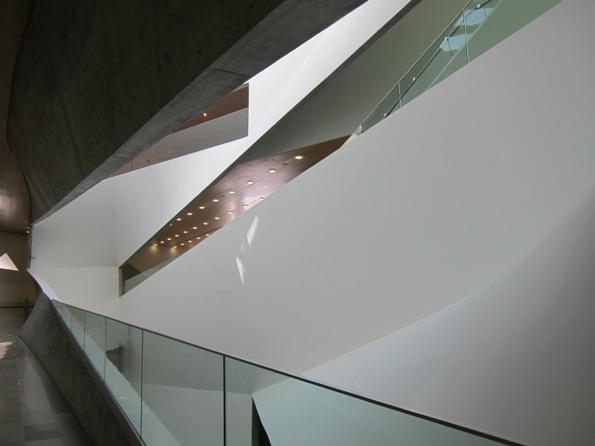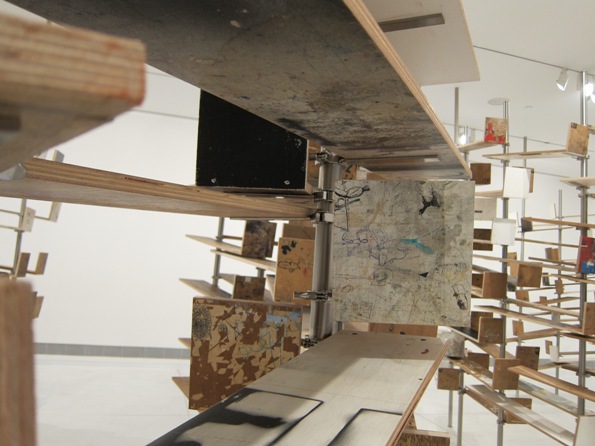
The Tel Aviv Museum of Art will celebrate the inauguration of the new Herta and Paul Amir Building, designed by Preston Scott Cohen with Shevirat Ha-Kelim: The Breaking of the Vessels, an exhibition of new and recent works by Anselm Kiefer. The new building, which doubles the museum’s exhibition space with 40,900 square feet of new galleries, will open to the public on November 2, 2011.
On Wednesday morning, October 26, 2011, moments after Anselm Kiefer inscribed the Ain-Sof on Shevirat Ha-Kelim, the artist addressed members of the press gathered for a preview tour of the new building: “When Omer (the late Prof. Mordechai Omer, Director and Chief Curator of the museum) asked me to do the first show at the Tel Aviv Museum I was a little surprised because its not self understood that a German artist opens the first show in a Jewish museum, I was very surprised and I felt a lot of responsibility. It was a big challenge for me. It is very rare to meet someone like Omer who thinks the artist is always right, so I could do what I want. It’s wonderful, it’s not always like this, it gives a lot of responsibility to the artist and a lot of challenge.”
“I’m not the first time here in Israel. I made my first exhibition here in’86. Gershom Scholem was still alive and then I studied a lot the Kabbalah and Jewish mysticism. When I was first in Jerusalem it was like an initiation of mine in my further artistic career. I’m really moved to be here now. When I was asked in 1990 (I was moving to France) what I think about the reunification [of Germany], and I told them that I think of another reunification that would forever be impossible, the reunification of the wonderful culture that we had in Germany in the first third of the 20th century: this collaboration between the Jewish and German culture, because without this element the German culture is only half. We didn’t have after war this profound literature that we had in the ‘20s and even the ‘30s. What I do now today is impossible, it’s a kind of virtual reunification what I strive to do in this exhibition.”
Walking through the new building is an exhilarating experience, full of light and intriguing angles. An 87 foot high spiraling atrium known as the Lightfall is at the center, with stairs and ramps twisting outward and leading into the five levels of galleries, bringing natural light into the different spaces within. Designer Preston Scott Cohen discussed the project at the press meeting. “I have been wondering whether a building like this could ever be built anywhere else in the world,” he said and noted that he worked with architect Amir Nemlich from the beginning. “The spaces we were trying to create,” said Scott Cohen, “meant that we had to have new approaches to the process…It was from the beginning a building about two ideas. One is a space for people coming together as we are now…[the other] a space for curatorial freedom and contemplation of art that totally gives itself to the art.”

The new space will enable the museum to grow in several dimensions. One of the welcome changes will be the ability to maintain dedicated galleries to display prints and drawings, photography, design and Israeli art. In addition to the Kiefer exhibition, which was organized by Prof. Mordechai Omer, exhibitions on view during the opening period will include: The Museum Presents Itself, a selection from the museum’s permanent collections of Israeli art curated by Ellen Ginton, the exhibit is divided into three chapters: Collective Identities, 1906-1960, Private Identities, 1960-1990, and Glocalism, 1990-2011; Making Room: Contemporary Israeli Photography – an installation of the museum’s holdings of Israeli photography of the past twenty years; two exhibitions of prints and drawings: Utopias of Expressionism and Cure by Expressionism; two exhibitions of Israeli design: Library by Chanan DeLange and Circle by Yaakov Kaufman, and Five Moments: Trajectories in the Architecture of the Tel Aviv Museum of Art, organized by guest curators Jascha Grobman and Ariel Blonder.
The Amir Building includes a spacious and inviting new library, and a 7,000-square-foot auditorium, enhancing its potential as a focal point for cultural activity.





